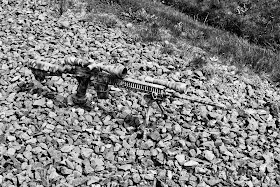..... the word comes from the French saying : "To blow smoke in the face of another". I think the frogs used it like our American saying..."blow smoke up someone's ass" or to confuse, lie or deceive, but that is just my guess.....
It came to mean: hide, blend in or disappear. I am sure most people know that camouflage should do two things, 1. break up the lines of the object to obscure its shape (making it harder to identify) and 2. help the item blend in with the surrounding environment. This means that the color, shading, shapes and lines are all important.
Here are some good examples.
Even ships used camo, this is called "Dazzle Camo", it breaks up the lines so you can't tell what you are looking at nor how large the object is
The new modern patterns hide the hunter so he looks like he is part of the tree
Before you go thinking that this idea came from the military.....nope nature taught us everything we know....
Different types of Camouflage
old school US Military Camo
Sometime in the last 25 years or so they switched to Digital Camo
U.S. Desert Camo
And the digital version
The latest US Army Camo design
The U.S. used this Tiger Stripe camo in Vietnam
old school urban camo,characterized by the use of whites and grays
One of the many varieties of snow camo
Rhodesian Camo
German camo, called "Flecktarn"
During the Cold War East Germany used this pattern called "Rain Camo"
Kryptek Camo
Original Mossy Oak
Original Real Tree
We could go on for days with all the different styles of camo, let's see some more examples of it in use
Some interesting articles on Camo
The Economist
Wikipedia
old school urban camo,characterized by the use of whites and grays
One of the many varieties of snow camo
Rhodesian Camo
German camo, called "Flecktarn"
During the Cold War East Germany used this pattern called "Rain Camo"
Kryptek Camo
Original Mossy Oak
Original Real Tree
We could go on for days with all the different styles of camo, let's see some more examples of it in use
Some interesting articles on Camo
The Economist
Wikipedia











































